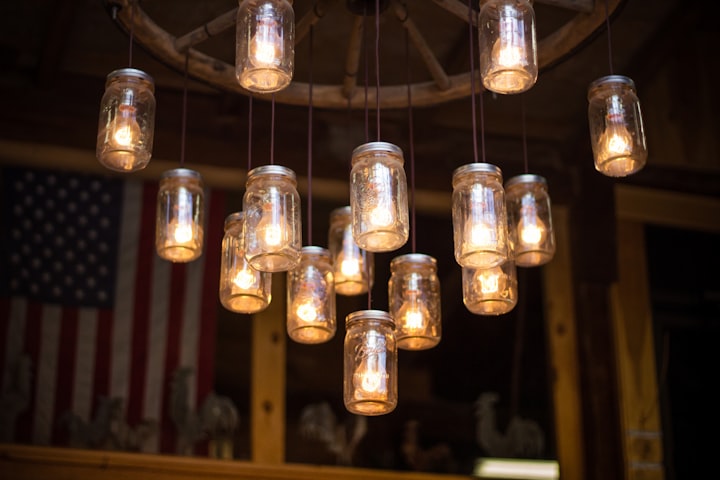What Is An Enclosed Light Fixture LED? The Bright, Long-Lasting Choice
Frustrated with short-lived LED bulbs? Learn about enclosed fixture LEDs – the heat-resistant solution for bright, reliable light in your enclosed light fixtures.

Ever notice your LED bulbs getting dark or dying early in some light covers? It might be because the cover traps heat. Regular LED bulbs, although energy-saving, still put out some heat, and this trapped heat can hurt them over time.
That's where enclosed light fixture LEDs come in! These specialized bulbs are designed to handle the extra heat buildup within enclosed spaces. They feature better heat management to ensure a long lifespan and consistent light output.
Why Choose Enclosed Light Fixture LEDs?
Longer Lifespan: Regular LED bulbs rely on heat sinks to dissipate heat. In an enclosed fixture, this heat gets trapped, raising the bulb's temperature and accelerating the degradation of its internal components. Enclosed fixture LEDs, however, address this issue in several ways:
Special heat sink design: These bulbs often have improved heat sinks made from materials with higher thermal conductivity, like aluminum or ceramic. This allows them to transfer heat more efficiently away from the LED chips.
Reduced power: Some enclosed fixture LEDs operate at a slightly lower wattage compared to a standard LED with the same brightness output. This lowers overall heat generation.
Advanced thermal management: Certain enclosed fixture LEDs incorporate built-in features like temperature sensors and automatic dimming to regulate heat and prevent overheating.
Consistent Brightness: Traditional LEDs trapped in enclosed fixtures can become dimmer over time due to heat-related damage. Enclosed fixture LEDs, with their superior heat management, maintain their original brightness for a much longer duration. This ensures consistent light output throughout their lifespan.
Energy Savings: To maximize the lifespan and performance of LEDs in enclosed fixtures, you can enjoy the long-term energy-saving benefits of LED technology. No more replacing bulbs frequently due to premature failure, and you get the consistent, bright light you need.
How to Identify Enclosed Fixture LEDs
Look for the wording "enclosed fixture rated" or similar terms on the bulb's packaging or description.
This indicates that the bulb has been specifically tested and certified to perform safely and reliably within enclosed light fixtures.
The packaging might also mention a maximum operating temperature, which should be higher than the typical operating temperatures of standard LED bulbs.
Additionally, some enclosed fixture LED bulbs may have a slightly different design compared to regular LEDs. They might have a larger heat sink base or a different housing material to facilitate better heat dissipation.
Ready for more?
Check out our blog page for a deep dive into enclosed fixture LEDs, including how to choose the right ones for your home and where to find them.
FAQs: Enclosed Fixtures LEDs
What is an enclosed light fixture?
An enclosed light fixture encloses the bulb with glass, metal, or plastic. This creates a sealed environment with little or no airflow around the bulb.
Common examples include:
- Ceiling fixtures with glass globes
- Outdoor porch or wall lights with sealed casings
- Recessed can lights with airtight trim
- Some track lighting
Why do I need special LEDs for enclosed fixtures?
LEDs are known for their energy efficiency, but they still generate heat while operating. The heat from an open fixture dissipates naturally into the air around it.
A fixture with an enclosed bulb, however, traps this heat. It is possible for the LED bulb to overheat as a result of this trapped heat.
LED bulbs that are overheated can have several consequences. In the first place, the bulb's lifespan can be significantly reduced. LEDs operate at specific temperatures.
An excessive amount of heat can damage the internal components of the bulb, resulting in premature failure. A second possibility is that the bulb will gradually dim.
Another sign of heat-related stress. LED bulbs in enclosed fixtures may overheat to the point of failure in extreme cases.
What's the difference between regular LEDs and enclosed fixture LEDs?
LEDs enclosed in fixtures are designed for the following conditions: Superior heat management: They may have larger heat sinks, more efficient materials, or built-in temperature sensors to prevent overheating.
Optimized power: Some may run at lower wattages to reduce heat generation.
How do I know if an LED bulb is suitable for enclosed fixtures?
Look for clear and unambiguous wording that indicates the bulb's suitability for enclosed fixtures. Here are some common terms you might find:
"Enclosed fixture rated" - This is the most straightforward and universally understood term.
"Suitable for enclosed fixtures" - Another clear indication that the bulb is designed for these conditions.
"Damp location rated" - While not exclusively for enclosed fixtures, bulbs with this rating can also handle heat buildup.
Damp locations are typically areas exposed to moisture but not direct water spray, like bathrooms or laundry rooms. These bulbs often have a higher maximum operating temperature compared to standard LEDs.
Can I use any light bulb in an enclosed fixture?
No. Each fixture will have recommendations. Maximum wattage for incandescent bulbs (heat is directly related to wattage).
Specific bulb types (LED, CFL, etc.)
Are enclosed LED fixtures more expensive?
They may be slightly more expensive than standard LED bulbs due to their specialized design. However, the longer lifespan and reliable performance of enclosed fixtures offset the cost over time.
Besides the enclosed fixtures, where else can I use these LEDs?
Enclosed fixture LEDs are appropriate for any situation where heat buildup is a concern.
- Outdoor fixtures exposed to direct sunlight
- An enclosed space with limited airflow
- Fixtures near heat sources
About the Creator
Joy Chaudhuri
I have been writing articles and blog content for more than 4 years. I enjoy writing about automobiles, lighting, and solar energy.
check past writing here: https://lightcheckup.com






Comments
There are no comments for this story
Be the first to respond and start the conversation.